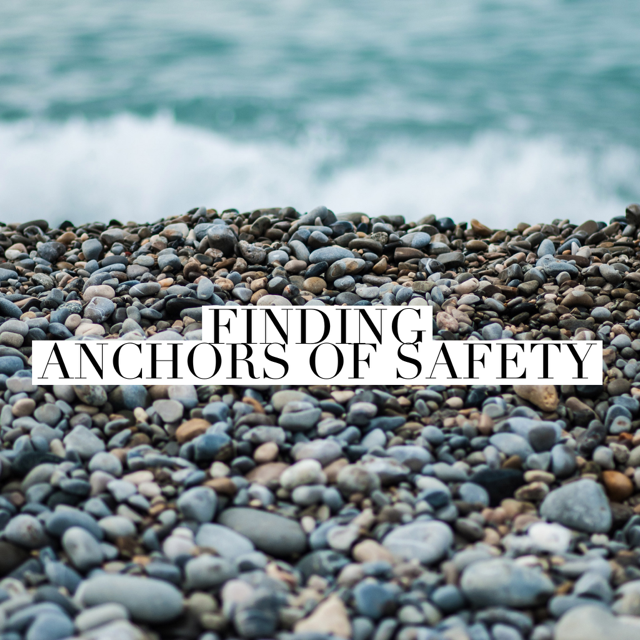
Our nervous system is our operating system, always working in the background to help us stay safe. We have come to believe that it's the brain that's in charge, but it's the nervous system that informs the brain, not the other way around.
The best way to lay a foundation for understanding the nervous system is Polyvagal Theory, which was developed by Stephen Porges in 1994. (You can read more about it here.)
Polyvagal Theory is a neuropsychological explanation of the vagus nerve's role in emotion regulation, social connection and fear response. It has become the blueprint for how we approach the healing process as it relates to trauma, anxiety and depression.
Clinical social worker Deb Dana recognized the need for a practical way to work with the three basic organizing principles of Polyvagal Theory. These are neuroception, heirarchy and co-regulation.
Neuroception is our built-in surveillance system that watches for signs of both safety and danger. It happens outside of our awareness, unlike perception which is a conscious process. Think of a baby smiling at their caregiver and crying with a stranger. Our response is also based on past experiences of unhealed trauma.
Knowing the three states of the nervous system allows us to more easily recognize which state we're in at any given moment. Then we can work with developing a pathway to awareness and regulation so we can anchor ourselves in safety as often as possible.
These three states are the ventral vagal state, which is known as our "rest and digest" state where we feel safe, aka the green zone. Fight or flight is when we're activated and possibly feeling worried or overly stressed. Here, our heart rate is elevated and we're ready to fight or flee, aka the yellow zone. The dorsal vagal state is when we feel stuck in procrastination, lacking motivation or disconnected, aka the red zone.
Co-regulation is regulating with another human being, which is a necessary experience for our survival. We are wired for connection and it is the way to safely navigate daily living.
So, when you find yourself in a state of fight or flight or shutdown (dorsal vagal) mode, tell yourself that this is your nervous system doing its job. When we can do this by shifting and looking through the lens of the nervous system, it can significantly reduce the inevitable self-blame and guilt that emerges. We do have to practice this because it will not come naturally.
For example, if you tune into your inner dialogue while in fear or shutdown mode, your self-talk might sound something like this: "What's wrong with me," "Why am I like this," "No one else has this problem," or "I'm so stupid."
Knowing that you have a choice of how to work with your nervous system can be liberating. Of course, it doesn't mean the end of emotional pain, but it does mean a more resilient and flexible nervous system.
Creating a list, or menu, of safety anchors, can help us to more efficiently regulate our emotional state and move more freely and flexibly within the three states of our nervous system. We can also develop "anchors of safety" to help us self-regulate.
Here are some examples of how you can develop a "menu" of safety anchors and anchor yourself in ventral vagal state.
First, consider "stretching the nervous system, not stressing it." As Deb Dana puts it, "the 'no pain, no gain' model doesn't work" when it comes to the nervous system. We need to find the right degree of challenge for ourselves. Remember, the nervous system is in charge. It will not let you go further than you're ready to go, so move slowly. No need to "power through."
Use prompts to build awareness of different states. Tuning into your body and the sensations you feel will tell you what state you're in. Next, complete the following sentences: "I am...." "People are....." and "The world is...."
For example, in general, in ventral vagal state, you will be breathing normally and be thinking, "I am safe." In fight or flight, you will feel your heart beating faster, your muscles will tighten and you may be thinking, "People are intimidating." In dorsal vagal state you may feel calm, but disconnected and unmotivated and may be thinking, "The world is not safe."
Keeping track of your responses will help you to notice patterns. Once you bring your patterns into awareness, you have the ability to make the shifts that you want.
Who, what, where and when. Use the categories of who, what, where and when to identify experiences of connection to intentionally activate these as regulating resources.
Who in your life makes you feel safe and welcome? What objects make you feel safe?
Where are the places that you feel safe? When are the times that you feel most regulated, safe and calm?
Have a moment of playfulness. When feeling worried or distressed playfulness may not easily come to mind, but if you write down and keep track of all the things you've done in the past that bring you joy, it will create a sense of hope and begin to change your state. It's a helpful reminder of the temporary nature of our various states.
Explore stillness. This may mean that you allow yourself to experience how it feels to be in a state of distress and then transition slowly to a moment of stillness. Thinking of nurturing words such as sanctuary, quiet, rest or solitude can feel safe and promote a sense of peace.
Create a playlist. Choose songs that help you move into a state of safety, joy, compassion, connection and restoration.
Caring for our nervous system is a practice in nurturing ourselves and emotional health. It takes patience, practice, commitment, curiosity and compassion. And you already have all the resources you need, it's just a matter of tapping into them!
